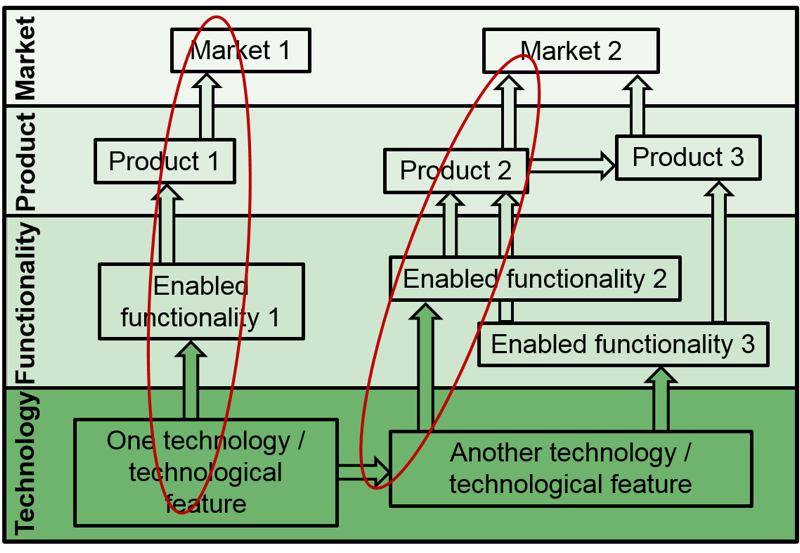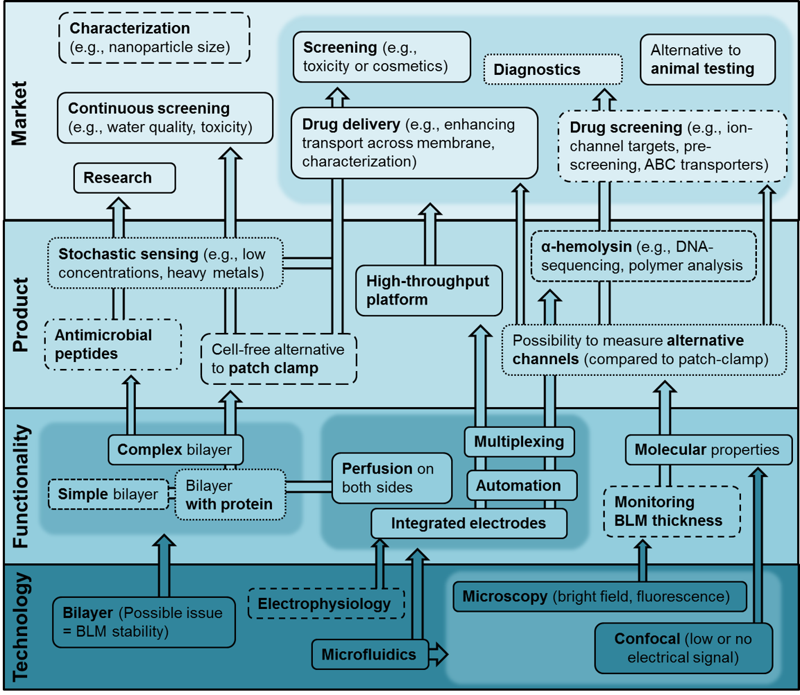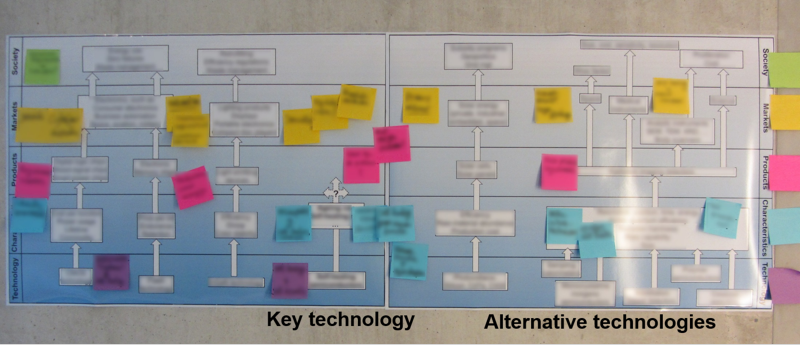Aim
Many technical research projects are curiosity driven and focus on specific technical characteristics that need to be discovered and developed. This makes it often challenging to envision an application already in the early stage when technical functionalities are not yet fully clear. The multi-path map helps to explore various applications and markets for a technology. If an application is envisioned already, this mapping exercise can be used to discover alternative applications. The multi-path map can thus be seen as an aid for researchers to think in a structured way about their technology and potential products and markets.
The multi-path map is inspired by the road mapping approach, a business tool for strategic planning, technology forecasting and agenda setting that is applied by large companies such as Motorola or Philips (Kostoff 2001; van Lente & van Til 2007). The map generally displays various technologies, products and markets that are connected by paths and that potentially exist in the future, as shown below. A road map or multi-path map can help to make strategic decisions and to align activities and resources – also in research.

Practical considerations and implementation
Characteristics | Practical implementation |
|---|---|
Suggested time Short (hours/days) Level of difficulty Straightforward Materials needed Pen/Paper People involved Researcher (you) |
|
Examples
The multi-path map approach has been tested various times during lectures with students who applied the map, individually or in groups, to their projects to get a better overview of possible application fields for the technology they were working on. In the examples presented here, the multi-path map has been applied in workshop settings, which has the advantage that a variety of perspectives can be fed into the map to broaden the scope of the outcomes.
New applications for a nanomedicine platform
An example of a multi-path map for a technical research project is shown below. Here, the PhD student was developing a microfluidic platform for the formation of artificial cell membranes (bilayer lipid membranes) with the original aim to create a platform for drug screening (Stimberg 2014, Schulze Greiving 2016).

The PhD student used the multi-path mapping approach in a workshop setting to explore alternative applications of the platform she developed. Participants with a variety of backgrounds, such as natural and social scientists, experts from (start-up) companies, regulation, and IP, were invited to the workshop. The lower layers of the multi-path map, the technological features and functionalities, were filled in rather quickly during the workshop as they were based on the work of the PhD student. Interestingly, during the completion of the upper layers of the map, additional ideas of potential products and markets were mentioned, such as using the platform for cosmetic screening. Additionally, possible issues in terms of technological functionality (stability of the lipid bilayer), as well as concerns about costs and resources of potential products were raised: choosing either optical or electrophysiological measurement schemes for example has an effect on the costs of the final product. For the PhD student, the multi-path map was a useful tool to explore potential applications for this particular technology and to structure the discussion during the workshop. Additionally, it provides an overview of potential pathways and serves as a map to guide the way between technologies and applications.
Research directions for a Young interferometer biosensor
In another example, a PhD student used the multi-path map in a workshop setting to explore applications for a Young interferometer sensor based on multiple wavelengths (Mulder, 2016). Here, the multi-path map was already created by the PhD student in advance and extended by the participants during the workshop (changes added in red). In contrast to the previous example, the participants of the workshop mainly had a technical background, with some experience in IP and social sciences. Therefore, discussion about potential products and markets was not as extensive, but important and interesting technical issues were discussed leading to the formulation of a number of questions for future research.

Applications and collaborators for a new research line
Here, the multi-path map has been applied in a workshop organized by a senior researcher to explore possible applications for his new research line. The multi-path map was created in advance by the senior researcher and was used to document the discussion during the workshop.

Relevant literature
- Kostoff, R.N. and R.R. Schaller, 2001, Science and Technology Roadmaps. IEEE TRANSACTIONS ON ENGINEERING MANAGEMENT, 48(2): p. 132-143.
- van Lente, H. and J. van Til, 2007, A Combined Roadmapping-Cluster Approach For Emerging Technologies. International Journal of Foresight and Innovation Policy, 3(2): p. 121-138.
- Robinson, D.K.R. and T. Propp, 2008, Multi-path mapping for alignment strategies in emerging science and technologies. Technological Forecasting and Social Change, 75(4): p. 517-538.
- Stimberg, V., 2014, Microfluidic Platform for Bilayer Experimentation - From a Research Tool towards Drug Screening. PhD thesis, University of Twente: Enschede.
- Schulze Greiving et al., 2016, ‘CTA-lite’ for exploring possible innovation pathways of a nanomedicine-related platform – embedded Responsible Research and Innovation in practice, In: DM Bowman, A Dijkstra, C Fautz, J Guivant, K Konrad, H van Lente and S Woll (eds), Responsibility and Emerging Technologies: Experiences, Education and Beyond, Berlin: AKA Press, 25-42. Read pdf here.
- Mulder, H., 2016, Size-selective analyte detection in an integrated optical Young interferometer biosensor. PhD thesis, University of Twente: Enschede, The Netherlands.
